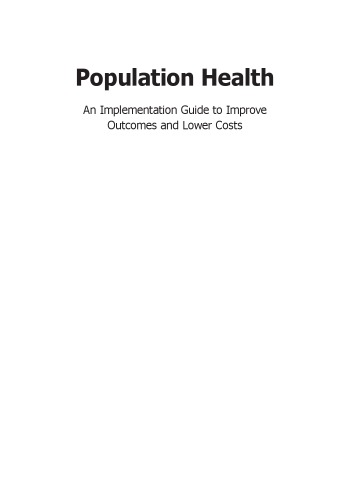Product desciption
Population Health An Implementation Guide To Improve Outcomes And Lower Costs Mayzell by Mayzell, George 9781498705561, 1498705561 instant download after payment.
As healthcare moves from volume to value, payment models and delivery systems will need to change their focus from the individual patient to a population orientation. This will move our economic model from that of a "sick system" to a system of care focused on prevention, boosting patient engagement, and reducing medical expenditures. This new focus will shift traditional financial accountability from the payer model to provider directed models. Population Health: An Implementation Guide to Improve Outcomes and Lower Costs covers not only the rationale for this transition, but also outlines successful practice models that are built to thrive in these new market dynamics. Besides the philosophical and the cultural aspects of these new models, it details the implementation and strategic initiatives required to succeed in today's value- and population-oriented healthcare environment. Describing what population health is, the book explains why it represents an opportunity for healthcare delivery systems, public health agencies, community-based organizations, and other entities to work together to improve health outcomes in the communities they serve. The book clarifies how the new models will impact healthcare providers, how to manage populations, and how to handle the risk factors involved. It details new delivery models, such as primary care and medical neighborhoods, and outlines the value proposition of screening and prevention in assigned populations.
Abstract: As healthcare moves from volume to value, payment models and delivery systems will need to change their focus from the individual patient to a population orientation. This will move our economic model from that of a "sick system" to a system of care focused on prevention, boosting patient engagement, and reducing medical expenditures. This new focus will shift traditional financial accountability from the payer model to provider directed models. Population Health: An Implementation Guide to Improve Outcomes and Lower Costs covers not only the rationale for this transition, but also outlines successful practice models that are built to thrive in these new market dynamics. Besides the philosophical and the cultural aspects of these new models, it details the implementation and strategic initiatives required to succeed in today's value- and population-oriented healthcare environment. Describing what population health is, the book explains why it represents an opportunity for healthcare delivery systems, public health agencies, community-based organizations, and other entities to work together to improve health outcomes in the communities they serve. The book clarifies how the new models will impact healthcare providers, how to manage populations, and how to handle the risk factors involved. It details new delivery models, such as primary care and medical neighborhoods, and outlines the value proposition of screening and prevention in assigned populations


